There are 450 species of birds in the Great Lakes State. If you’re wondering how many of these you can commonly see in your backyard in Michigan, then this article is for you! Below, we’re sharing information and descriptions of common backyard birds of Michigan so you can better identify and attract them.
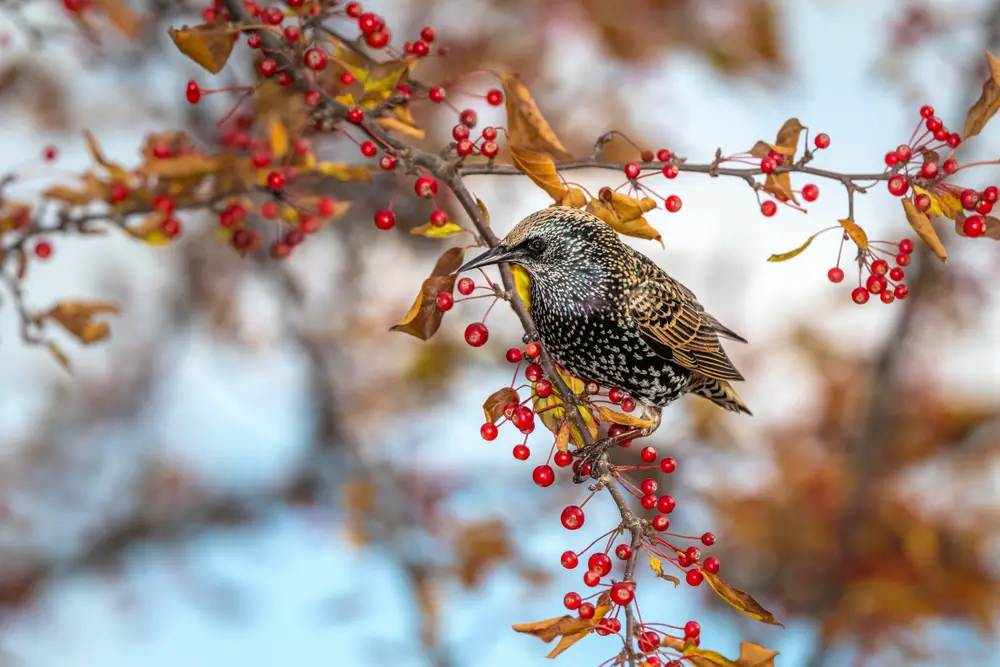
For more bird reading, visit these articles about the Backyard Birds of Texas and the Backyard Birds of Kentucky!
Table of Contents
1. Black-Capped Chickadee
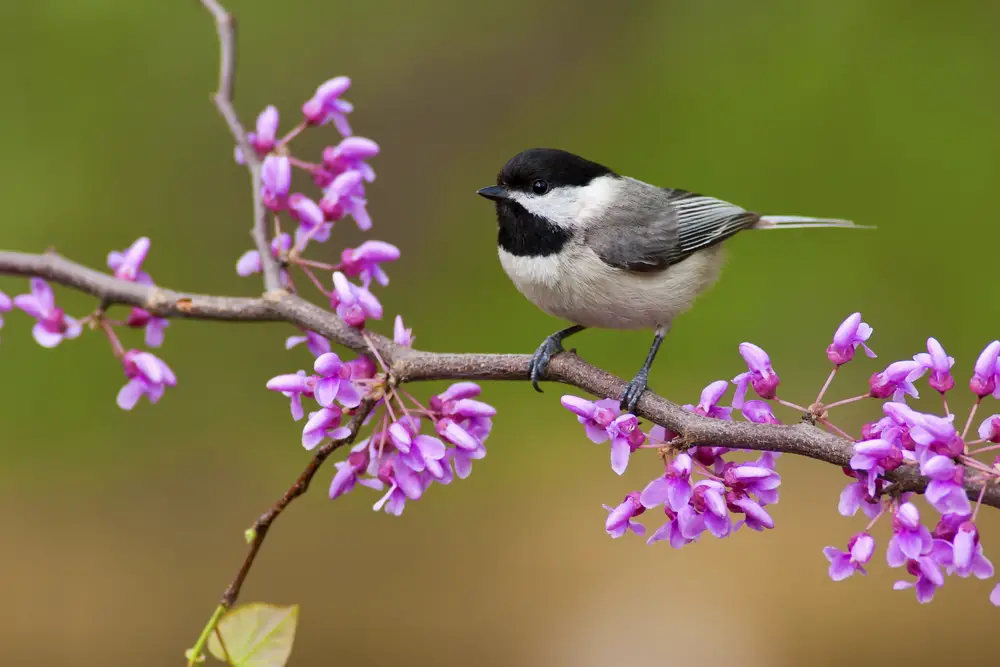
Information
- Scientific Name: Poecile atricapillus
- Length: 7 to 5.9 inches
- Wingspan: 3 to 8.3 inches
- Weight: 3 to 0.5 ounces
Description
Common throughout the year, these tiny birds are characterized by having a black “cap” and bib that sharply contrasts with their white cheeks. The rest of their body is blackish grey and white.
Black-Capped Chickadees are frequent visitors of bird feeders and won’t hesitate to be one of the first birds to greet you once you set up a new tube, tray, or hopper feeder in your yard.
They love seeds, insects, and berries (especially black sunflower seeds!).
2. Blue Jay
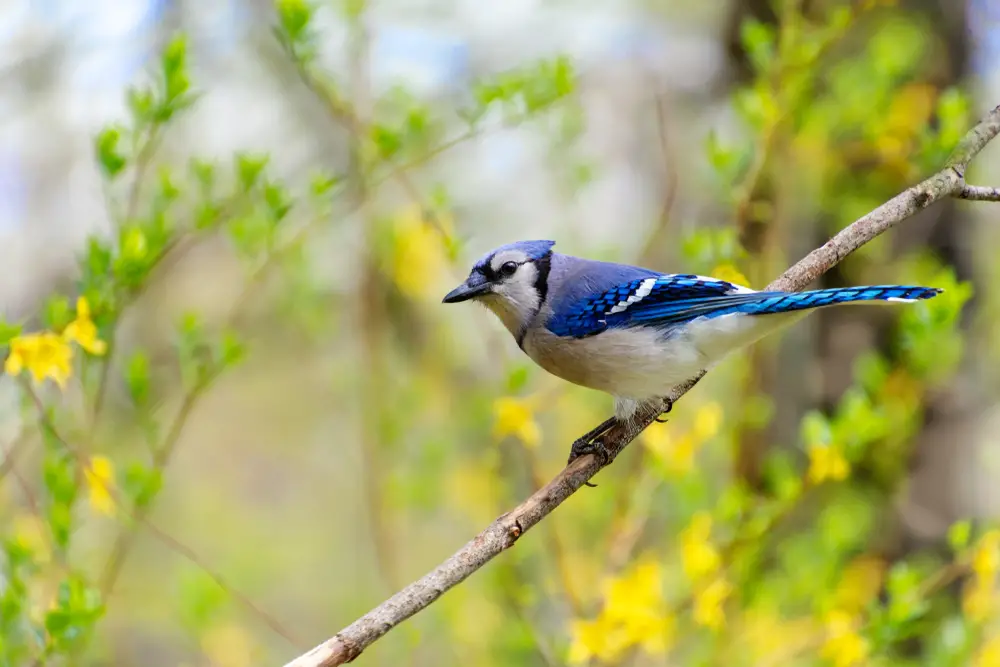
Information
- Scientific Name: Cyanocitta cristata
- Length: 8.6 to 1.8 inches
- Wingspan: 13.3 to 16.9 inches
- Weight: 2.5 to 3.5 ounces
Description
Blue Jays have a very distinct look thanks to the large feathery blue crown that decorates their heads. The top half of their bodies is mostly blue and the bottom is an off-white color.
You can also see these birds sporting a black circle tracing the outline of their neck, producing a necklace-like shape.
Year-round inhabitants of the whole state, these birds are common visitors of platform and peanut feeders. They crack and eat nuts, seeds, and berries.
3. American Robin
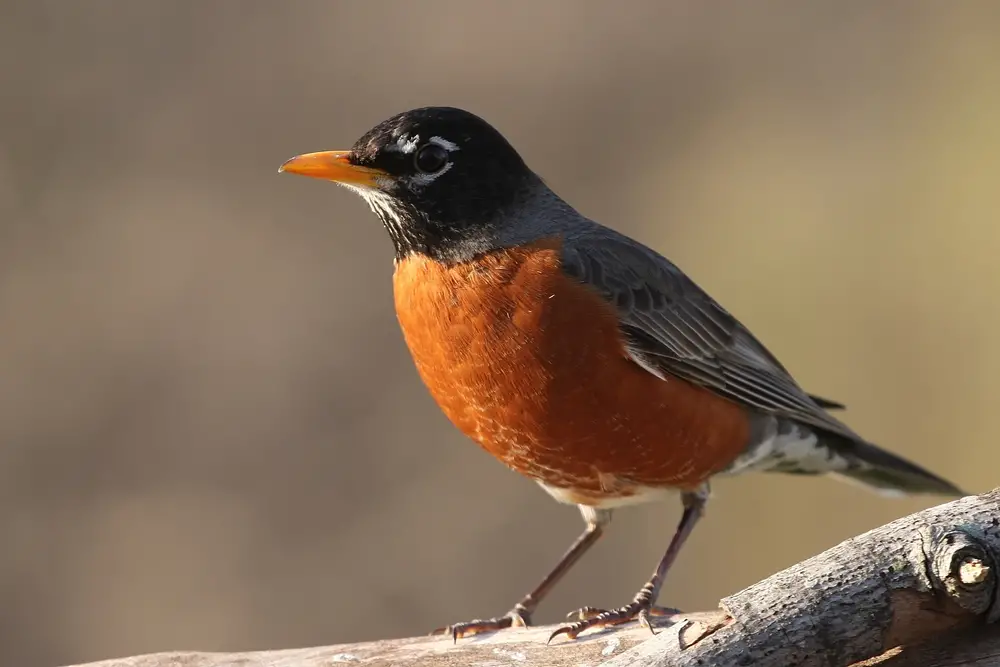
Information
- Scientific Name: Turdus migratorius
- Length: 9.0 to 11.0 inches
- Wingspan: 14.7 to 16.5 inches
- Weight: 2.3 to 2.8 ounces
Description
Not only is it a common visitor of backyards, but the American Robin is also Michigan’s state bird. It has a rusty orange underside and a matching beak that contrasts against its greyish-brown body.
These birds prefer a diet consisting of worms and other small invertebrates. They’re not big fans of seeds, so they don’t often stop by feeders.
You can lure them to your yard with mealworms, birdbaths, and fruiting plants.
4. Northern Cardinal
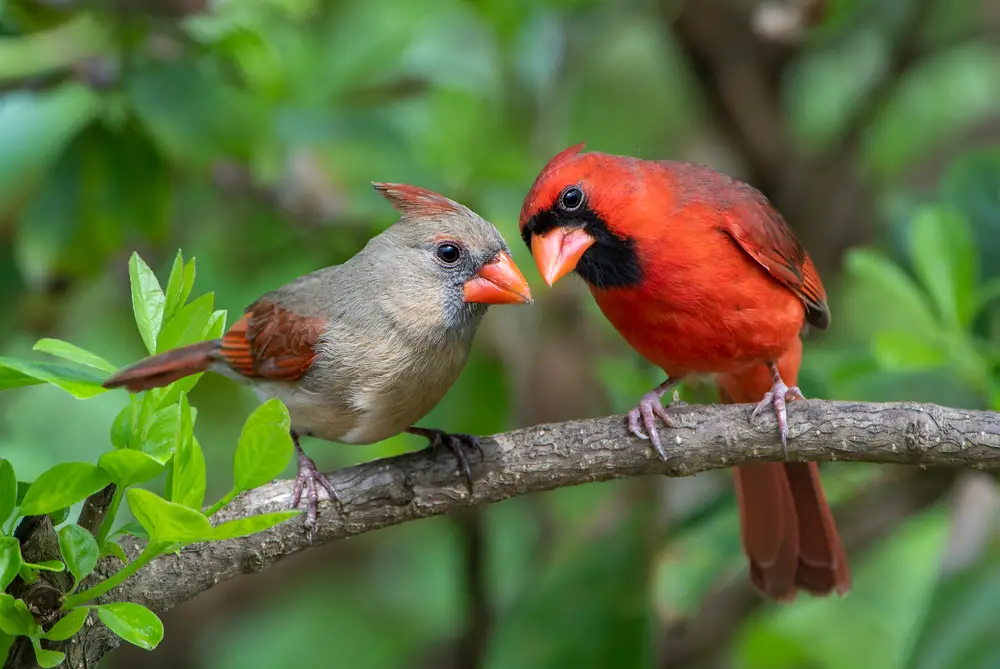
Information
- Scientific Name: Cardinalis cardinalis
- Wingspan: 8.9 to 12.2 inches
- Length: 8.3 to 9.1 inches
- Weight: 1.5 to 1.7 ounces
Description
Northern Cardinals are among the most recognizable backyard birds not only in Michigan but also throughout North America.
Males possess bright red bodies while females have paler brown feathers. Both sexes are easily identifiable thanks to their iconic mohawks and red-orange beaks.
Year-round inhabitants of Michigan, these birds prefer visiting large tray and hopper feeders. Their favorite diet consists of seeds such as black sunflower seeds, berries, and nuts.
5. American Goldfinch
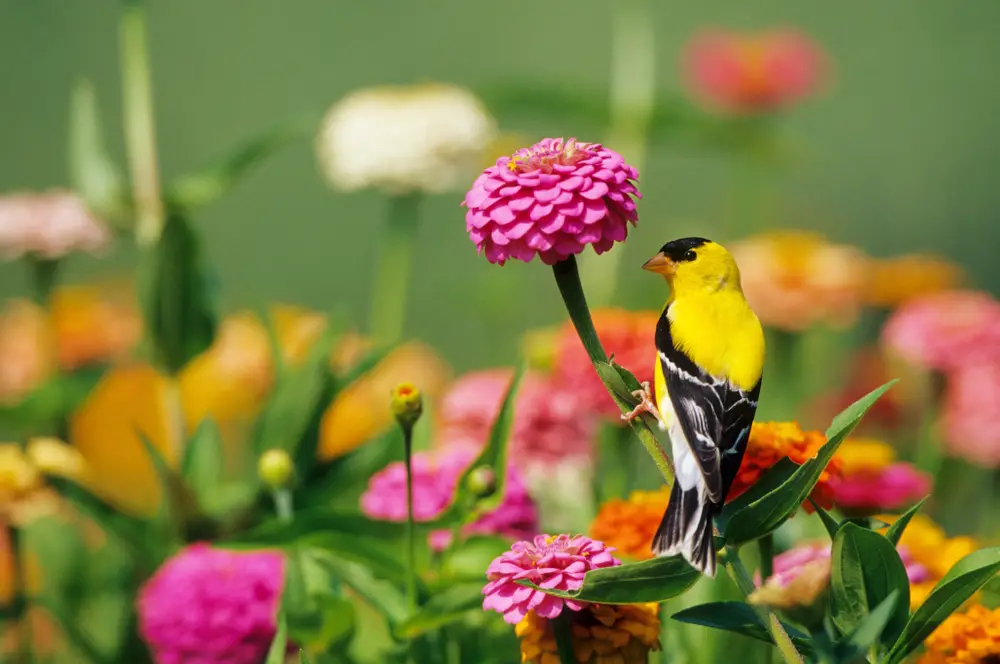
Information
- Scientific Name: Spinus tristis
- Length: 4.3 to 5.5 inches
- Wingspan: 7.5 to 8.7 inches
- Weight: 0.39 to 0.71 ounces
Description
Informally called the wild canary, the American Goldfinch is a favorite to many birdwatchers especially during the summer. During the summer, the males boast a bright lemon yellow coat, coupled with a black cap and black wingtips.
Females (and males during winter) are duller-looking with olive or greyish-yellow feathers, and brown bodies. Both sexes are sized similarly to a chickadee.
These birds are seen all year in Michigan and particularly enjoy thistle feeders. They may also feed on black sunflower seeds.
6. Mourning Dove
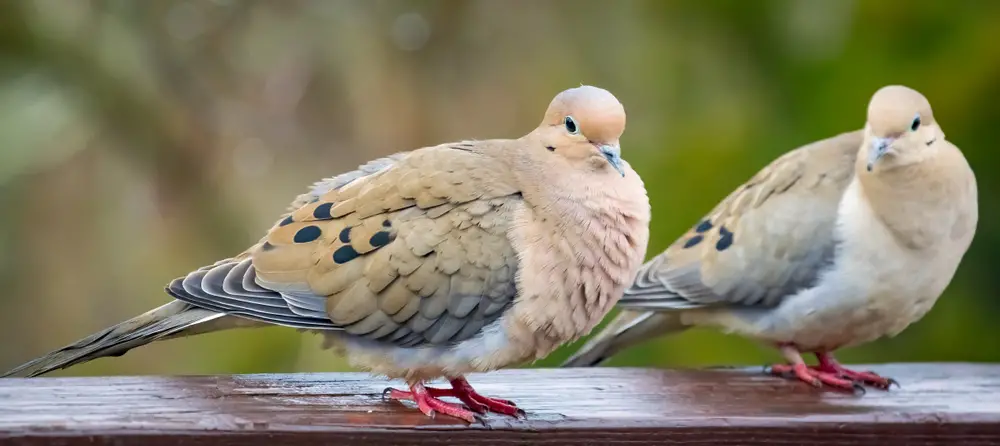
Information
- Scientific Name: Zenaida macroura
- Length: 9.1 to 13.4 inches
- Wingspan: 17.7 inches
- Weight: 3.4 to 6.0 ounces (Male) 3.0 to 5.5 ounces (Female)
Description
A bit larger than the American Robin, Mourning Doves are usually found perched on wires, fences, or in trees. They may visit your tray feeder, but you’re more likely to see them walking at ground level.
These birds have grey bodies topped with black spots. Their undersides are a pale peach color and their eyes are surrounded by a unique cyan-colored ring.
Although these doves frequently stop by feeders, they prefer searching for seeds on the ground. To attract them, put black sunflower seeds on tray feeders or sprinkle the seeds on the ground.
7. American Crow
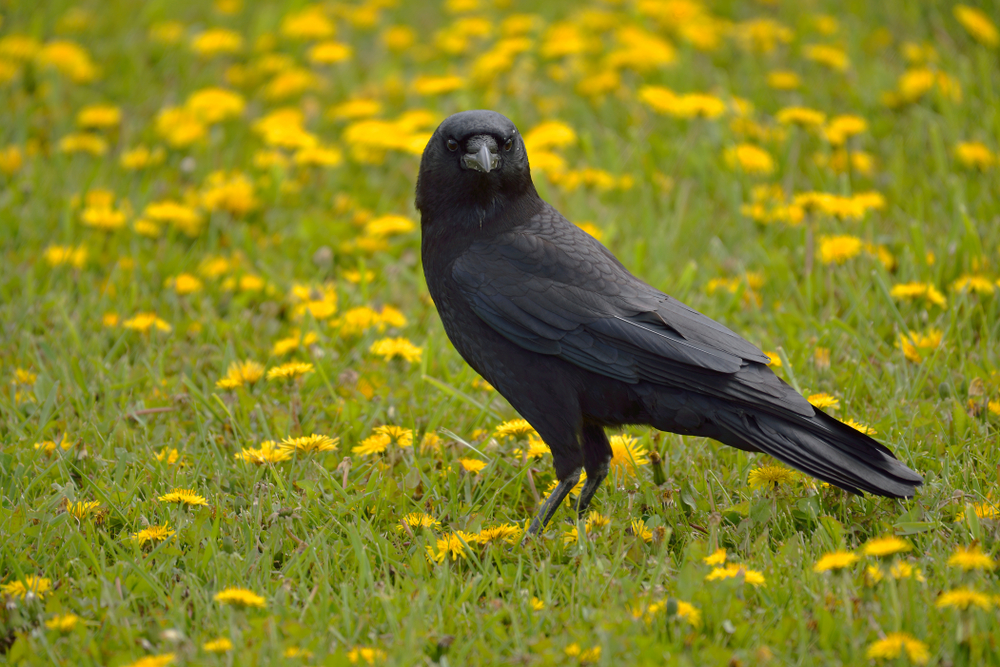
Information
- Scientific Name: Corvus brachyrhynchos
- Length: 15.8 to 20.9 inches
- Weight: 11.2 to 21.9 ounces
- Wingspan: 33.5 to 39.4 inches
Description
American Crows have entirely black bodies. They’re relatively large and produce a cawing call that many people are familiar with.
American Crows are also very intelligent birds with impressive problem-solving skills. They like to remain high in treetops to maintain a bird’s eye view of their surroundings.
These birds are year-round residents all over the state of Michigan. They’re omnivorous and rarely visit bird feeders due to their large size.
8. Downy Woodpecker
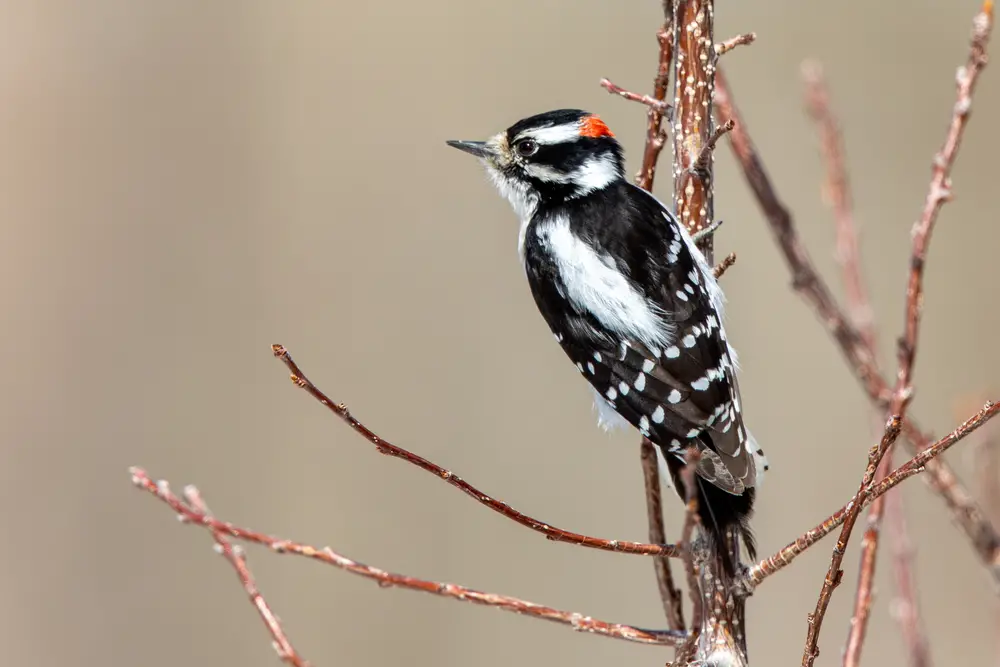
Information
- Scientific Name: Dryobates pubescens
- Length: 5.5 to 7.1 inches
- Wingspan: 9.8 to 12.2 inches
- Weight: 0.7 to 1.1 ounces
Description
Downy Woodpeckers are the smallest of their kind across North America. They’re always among the first visitors of a new bird feeder, found year-round throughout the whole state of Michigan.
You can easily tell them apart thanks to the characteristic red patch on the back of the males’ heads (not present in females). Both sexes have black and white striped heads, like the Hairy Woodpecker, but smaller bodies.
These birds like just about any type of bird feeder. They eat black sunflower seeds, insects, and fruits.
9. White-Breasted Nuthatch
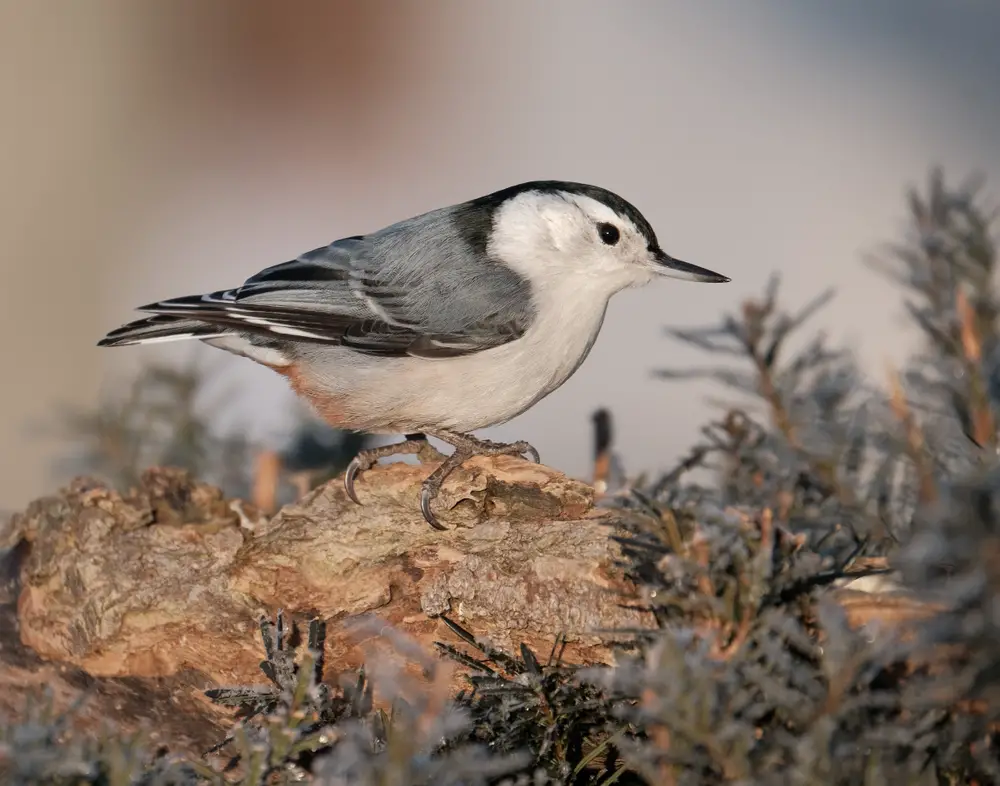
Information
- Scientific Name: Sitta carolinensis
- Length: 5.1 to 5.5 inches
- Wingspan: 7.9 to 10.6 inches
- Weight: 0.6 to 1.1 ounces
Description
The White-Breasted Nuthatch is a very common backyard bird in Michigan, residing throughout the entire state all year. They’re called “nuthatch” because they shove nuts under tree bark then hatch them out with their sharp beaks.
To identify these birds, look for a unique bold black stripe sitting on the top of the head, grey and black wings, and a white face and belly.
These birds like just about any type of bird feeder. They eat black sunflower seeds, peanuts, and insects.
10. Song Sparrow
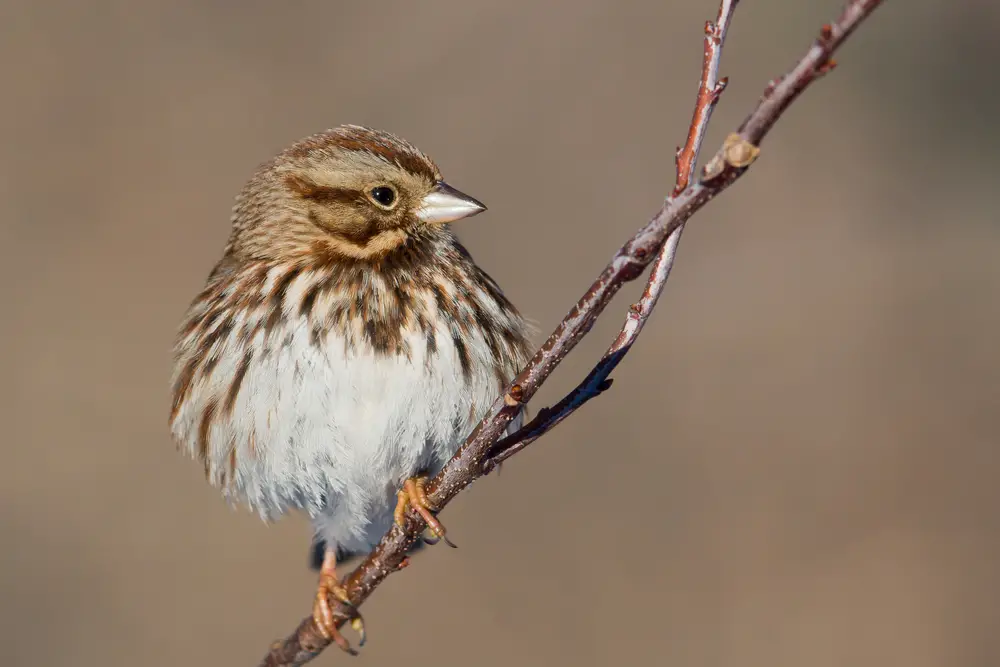
Information
- Scientific Name: Melospiza melodia
- Length: 4.7 to 6.7 inches
- Wingspan: 7.1 to 9.4 inches
- Weight: 0.4 to 1.9 ounces
Description
Similar to other brown-streaked sparrows, these birds have mostly brown bodies with deep brown streaks on their white undersides. They’re commonly seen across North America with varying plumage, depending on the region.
Male Song Sparrows attract females and defend their homes using their special songs. You can find them year-round in the lower peninsula of Michigan.
They like to eat mixed seeds, so they’ll often visit tray and hopper bird feeders for a snack.
11. Red-Bellied Woodpecker
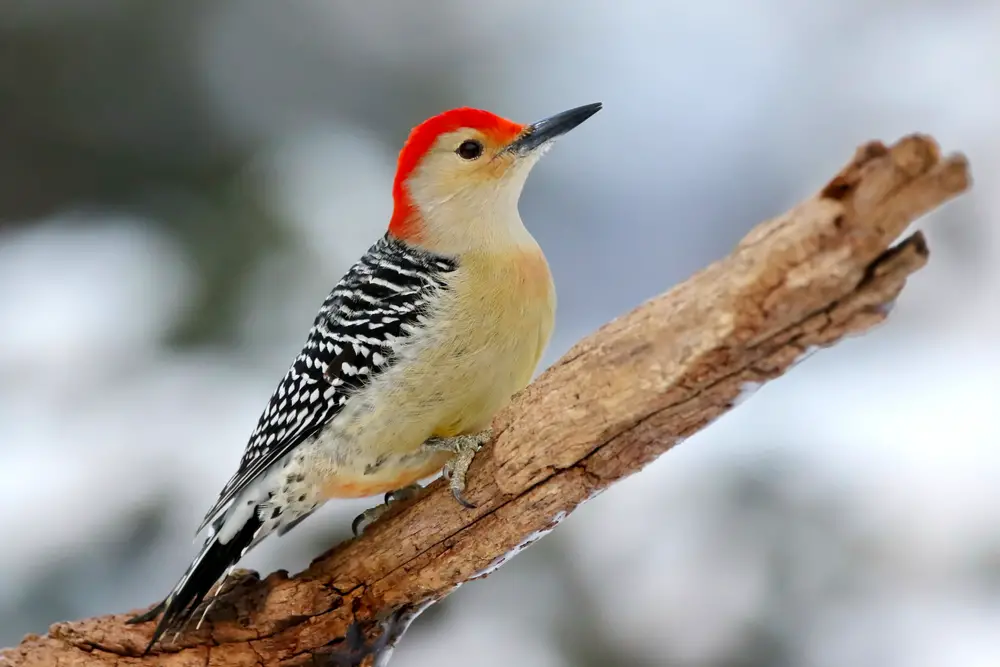
Information
- Scientific Name: Melanerpes carolinus
- Length: 9.2 to 10.3 inches
- Wingspan: 15.7 to 17.8 inches
- Weight: 2.2 to 3.2 ounces
Description
These woodpeckers are medium-sized and moderately common, found in backyards and at bird feeders.
Despite what their “red-bellied” name suggests, the noticeable red part on their bodies is actually a bright streak that runs down the back of their heads and to their necks. Their belly area is mostly white with a red-washed patch that you can spot if you look carefully enough.
Another distinct feature of these birds is their wings, decorated with characteristic black and white barring.
Red-bellied Woodpeckers are chiefly inhabitants of lower Michigan. They prefer suet feeders but will visit seed feeders from time to time.
12. European Starling
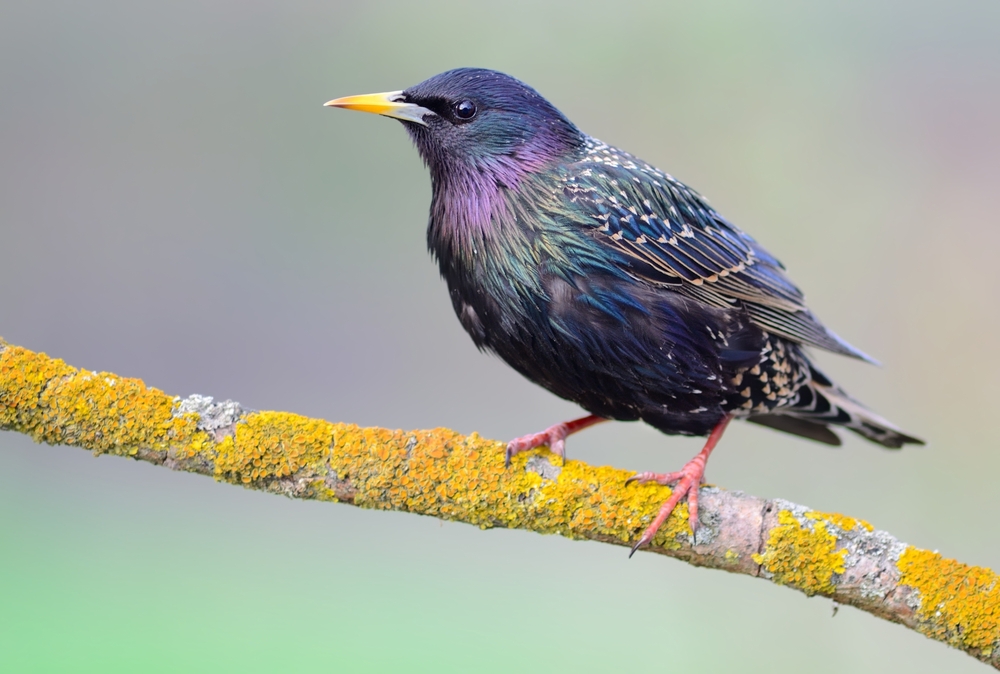
Information
- Scientific Name: Sturnus vulgaris
- Length: 7.9 to 9.1 inches
- Wingspan: 12.2 to 15.8 inches
- Weight: 2.1 to 3.4 ounces
Description
Often considered as pests, European Starlings are a grade-A example of invasive species. In the 1890s, 100 of these birds were released in New York. Since then, they’ve taken the county by storm thanks to their remarkable adaptability skills.
Although they wreak havoc on other birds by destroying their nests, and killing their younglings, their appearance doesn’t expose their harmful behavior. These birds look mesmerizing with dark-colored bodies that produce a mixture of purple, green, and blue iridescence in daylight.
They also sport yellow beaks and feet, as well as specks of white on their wings and down their backs. They’re year-round inhabitants that you find throughout the entire state.
Additionally, their high adaptability allows them to eat just about anything. You really don’t need to offer any specific food to attract them, they’ll invite themselves to your backyard either way.
13. Tufted Titmouse
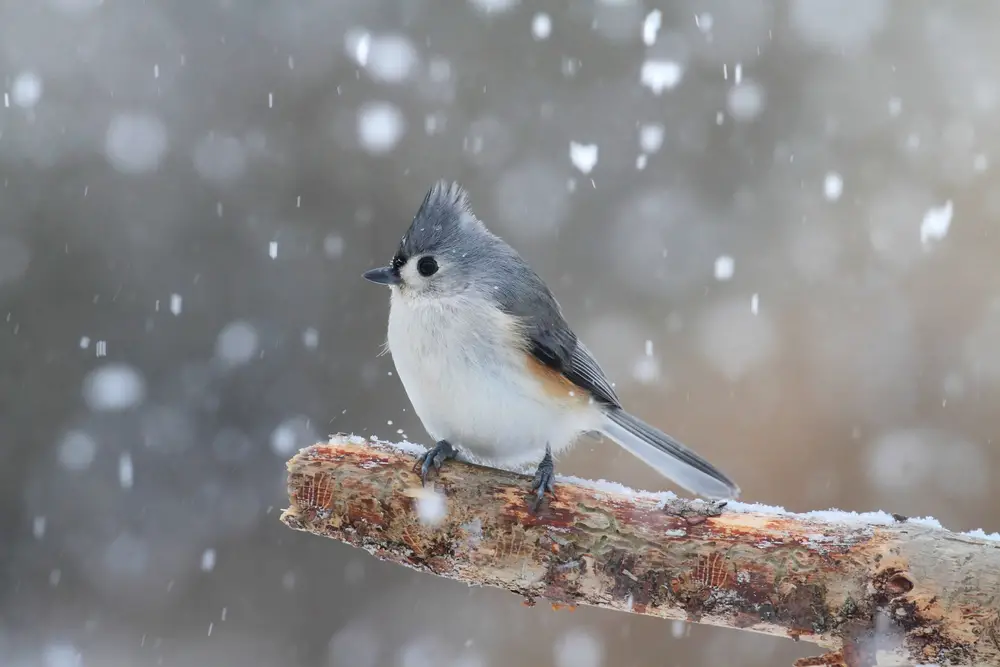
Information
- Scientific Name: Baeolophus bicolor
- Length: 5.5 to 6.3 inches
- Wingspan: 7.9 to 10.2 inches
- Weight: 0.6 to 0.9 ounces
Description
These tiny birds are frequent visitors of backyards and feeders in Michigan. Similar to the Northern Cardinal, they have distinct small mohawks that can help you in identifying them.
Otherwise, Tufted Titmice have bodies that are silver on top and greyish white on the bottom. They also carry a black mark just over their black beaks.
In the lower peninsula, these birds are present year-round. However, they’re not very common in the upper peninsula.
14. House Sparrow
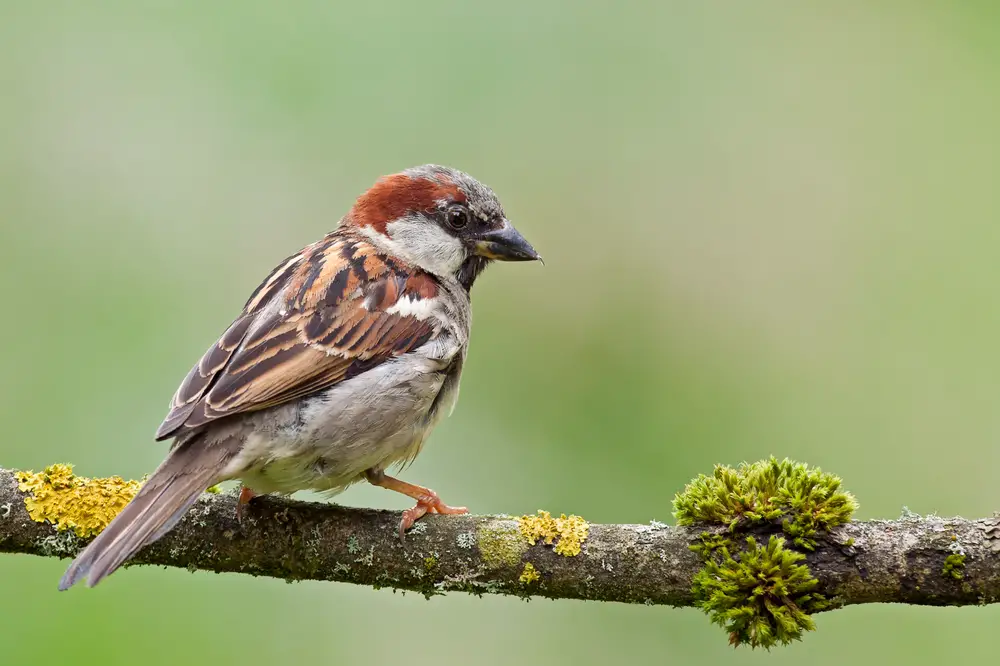
Information
- Scientific Name: Passer domesticus
- Length: 5.9 to 6.7 inches
- Wingspan: 7.5 to 9.8 inches
- Weight: 0.9 to 1.1 ounces
Description
House Sparrows are generally considered pests. Other than starlings, these birds are the only wild bird species that you can legally capture and humanely put down in the United States.
They were also set free in New York, and have taken over the country ever since. They’re known for demonstrating an aggressive nature towards other birds, particularly in their nesting areas.
These invasive birds have brown bodies with a bit of black and dark brown streaking on their chests and wings. They’re year-round inhabitants that you find throughout the entire state.
They’ll eat just about anything, threatening native species in the process.
15. Dark-Eyed Junco
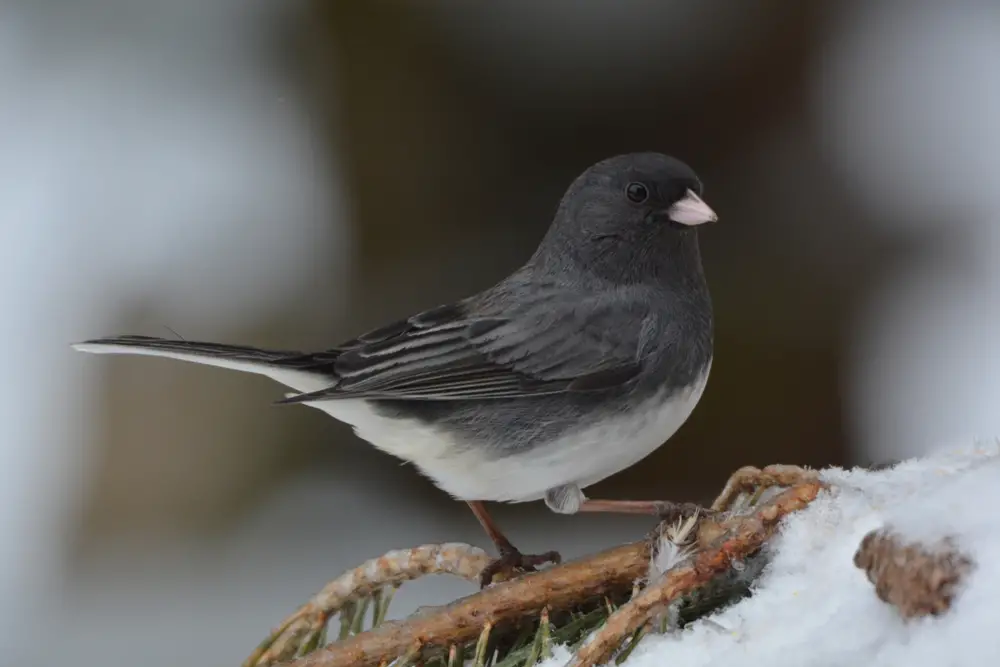
Information
- Scientific Name: Junco hyemalis
- Length: 5.5 to 6.3 inches
- Wingspan: 7.1 to 9.8 inches
- Weight: 0.6 to 1.1 ounces
Description
Dark-Eyed Juncos fly to Canada for the summer, so they’re considered by folks in the United States to be winter birds.
Their bodies are black-grey with a darker shade on top fading into light grey and white towards the bottom. However, females and juvenile Juncos are more on the buffy brown side. Both sexes have pink beaks.
You can find these birds near wooded areas and forests year-round across Northern Michigan. They prefer to stay close to the ground, mostly hopping around.
This is why Juncos don’t frequently visit feeders; they like to scour for food on the ground. As such, sprinkling seeds can effectively attract these birds.
16. Northern Flicker
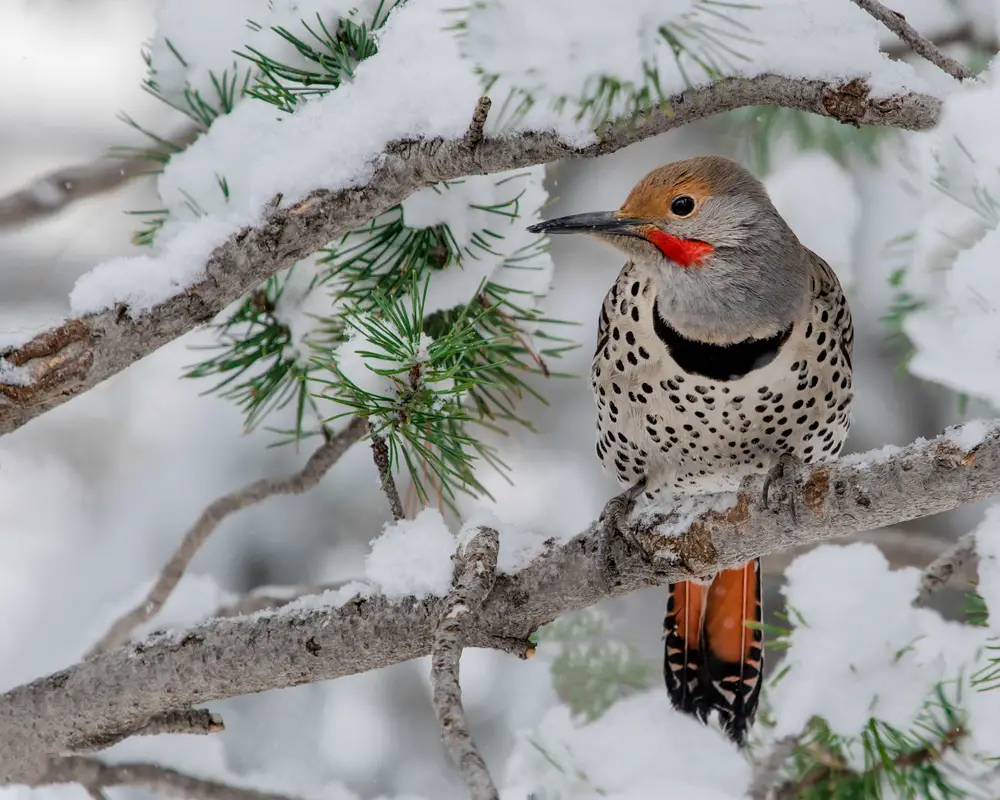
Information
- Scientific Name: Colaptes auratus
- Length: 0 to 12.2 inches
- Wingspan: 5 to 20.1 inches
- Weight: 9 to 5.6 ounces
Description
Northern Flickers are common backyard birds across the United States, not just Michigan. They’re medium to large in size and like to feed mainly on insects. As such, they’re not regular visitors of feeders.
They have a red patch on the backside of their necks, black dots on their underside, barred grey and black wings, and an all-black bib. Northern Flickers in Michigan have wings with yellow feathers on the underside — this variety is called yellow-shafted.
In the lower peninsula, you can see these birds year-round, but only throughout the breeding season north of that. If you’re hoping to attract these birds to your backyard, consider setting up a birdbath.
17. House Finch
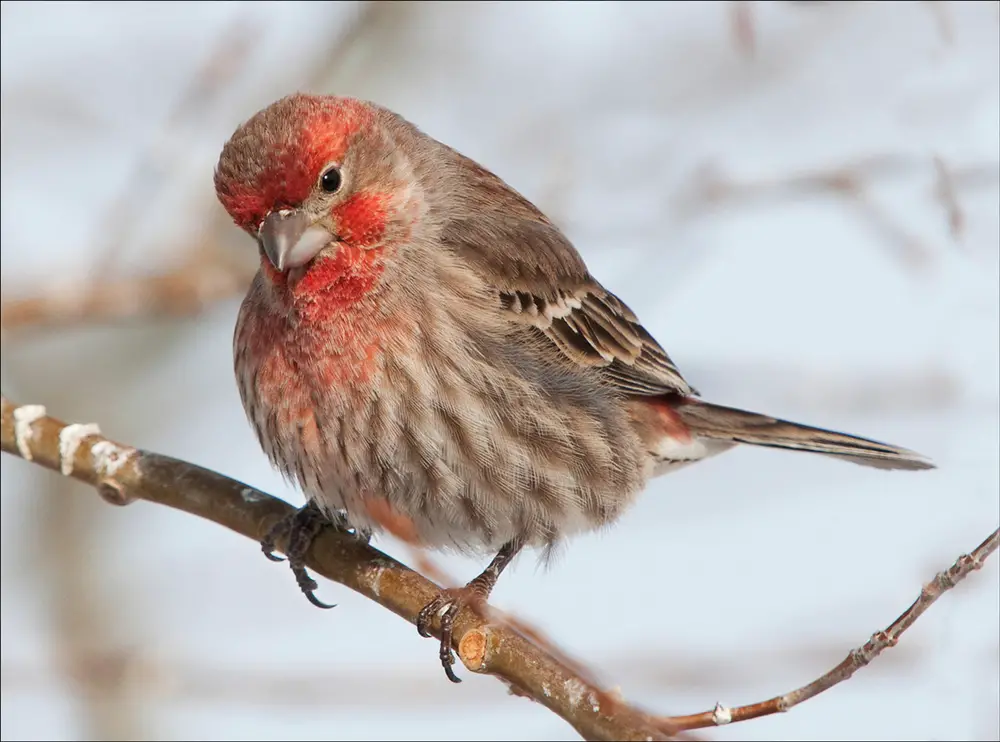
Information
- Scientific Name: Haemorhous mexicanus
- Length: 4.9 to 6.1 inches
- Wingspan: 8.1 to 10.5 inches
- Weight: 0.6 to 0.9 ounces
Description
Another backyard bird you can expect to spot frequently in Michigan is the House Finch. Despite being an invasive species, they’re not as despised as House Sparrows because they’re not as destructive.
Present in the lower peninsula only, these birds may show up at your feeders in big flocks and hoard the feeders. The male House Finch is easier to identify than females – which are exclusively brown – because they have a reddish color peppered on their heads and chests.
Compared to Goldfinches, these birds visit feeders more frequently. Black sunflower seeds are effective to lure them in.
18. Hairy Woodpecker
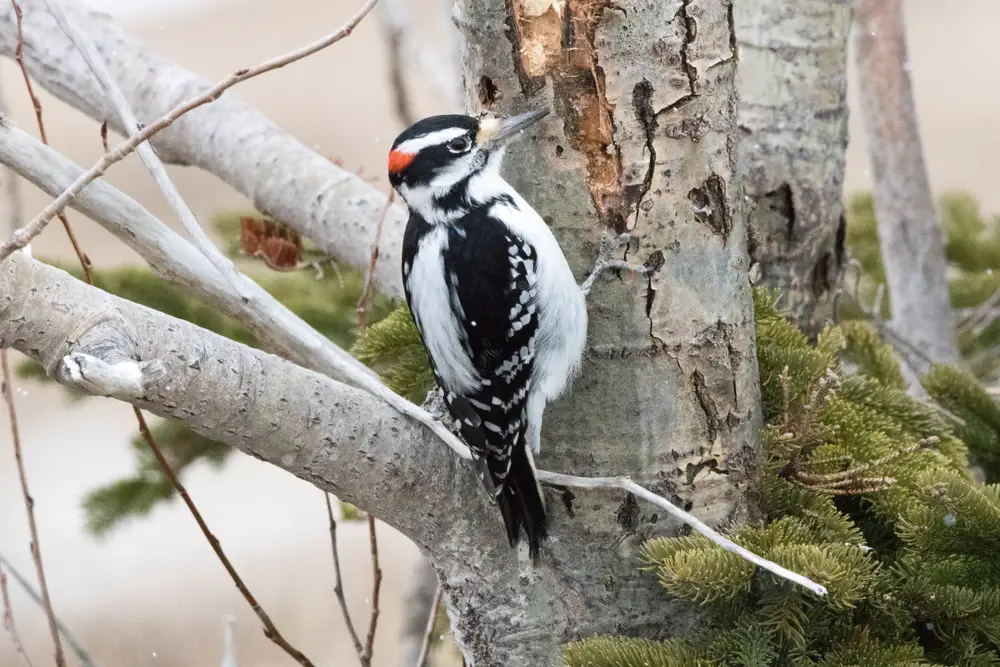
Information
- Scientific Name: Dryobates villosus
- Length: 1 to 10.2 inches
- Wingspan: 0 to 16.1 inches
- Weight: 4 to 3.4 ounces
Description
Hairy Woodpeckers look pretty similar to Downy Woodpeckers, except they’re larger and lack the red mark on the back of the neck. Both birds are even found in the same parts of the state year-round.
Although Hairy Woodpeckers don’t stop by bird feeders as often, they’re still attracted to seed and suet feeders.
Wrap Up
There you have it, the 18 most common backyard birds of Michigan. The information and descriptions we shared will help you tell them apart, all you have to do is keep your eyes open!
